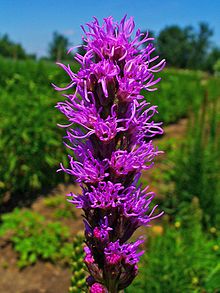Liatris spicata
| Liatris spicata | |
|---|---|
 |
|
| Scientific classification | |
| Kingdom: | Plantae |
| (unranked): | Angiosperms |
| (unranked): | Eudicots |
| (unranked): | Asterids |
| Order: | Asterales |
| Family: | Asteraceae |
| Genus: | Liatris |
| Species: | L. spicata |
| Binomial name | |
|
Liatris spicata (L.) Willd. |
|
Liatris spicata, the dense blazing star or prairie gay feather, is an herbaceous perennial flowering plant in the sunflower and daisy family Asteraceae. It is native to eastern North America where it grows in moist prairies and sedge meadows.
The plants have tall spikes of purple flowers resembling bottle brushes or feathers that grow one to five feet tall. The species grows in hardiness zones 3 - 8, stretching from the Midwest to the East Coast and eastern Canada.
Common varieties include 'Alba' and 'Floristan White' which are white-flowering cultivars on 1 1⁄2-foot (45 cm) tall spikes, 'Callilepsis' with long stems good for cut flowers, 'Floristan Violett' with a strong stem and thick, violet flower spikes preferred by florists, and 'Kobold' which stays small in size with deep purple flowers.
Liatris spicata var. resinosa is found in the southern part of the species's natural range, the variable plants have only 5 or 6 flowers per head and the heads are more widely spaced on the stems, these differences are more pronounced when the plants are found in drier and coastal habitats.
Liatris spicata is a garden flower in many countries around the world, grown for its showy purple flowers (pink or white in some cultivars). They bloom in July through August or September, depending on where in their range they are located.
Under cultivation it is found under many names including button snakewort, Kansas gay feather, blazing star, Liatris callilepis.
Full sun is best and well-drained soil is preferred to prevent rot, though the plants do prefer moist soil. However, the plants do not tolerate wet soil in winter. The plants can tolerant some shade as well as drought but need regular watering during the first growing season to build strong roots.
Plants can be grown from corms (similar to bulbs and tubers) or from seed, or the plants can be bought at garden centers or nurseries.
To grow from seed, start in early spring either indoors or outside. Germination takes 20–45 days. When leaves appear, divide in large clumps. Plants should be spaced 12-15 inches apart. Spacing allows sun and air to help with potential diseases such as stem rot (Sclerotinia sclerotiorum), leaf spots (Phyllosticta liatridis, Septoria liatridis), rusts (Coleosporium laciniariae, Puccinia liatridis), powdery mildew (Erysiphe cichoracearum), and wilt (Verticillium albo-atrum). When growing from seed, blooms do not usually appear until the second year.
...
Wikipedia
